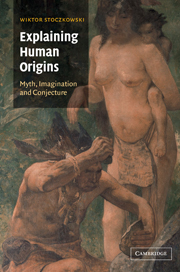Book contents
- Frontmatter
- Contents
- List of tables
- Acknowledgements
- Introduction: in which the author briefly explains his aims
- 1 Prehistory and the conditioned imagination
- 2 Anthropogenesis and science
- 3 In search of causes
- 4 Evolutionary mechanisms: the constraints of nature or of imagination?
- 5 A double game
- Bibliography
- Index
Introduction: in which the author briefly explains his aims
- Frontmatter
- Contents
- List of tables
- Acknowledgements
- Introduction: in which the author briefly explains his aims
- 1 Prehistory and the conditioned imagination
- 2 Anthropogenesis and science
- 3 In search of causes
- 4 Evolutionary mechanisms: the constraints of nature or of imagination?
- 5 A double game
- Bibliography
- Index
Summary
On a coutume de s'étonner que l'esprit humain soit si infini dans ses combinaisons et ses portées; j'avouerais bien bas que je m'étonne qu'il le soit si peu.
C. A. Sainte-Beuve, Portraits littérairesCustom requires famous scholars to be depicted alongside their preferred instruments of observation: Copernicus with an astrolabe in his hand, Galileo looking through a telescope, Pasteur bending intently over a microscope. In the common-sense imaginary, the scientist is first and foremost an observer of the world, and all his knowledge can proceed only from observation.
The history and sociology of science have importantly rectified this naïve picture, by demonstrating that scientific thought is subject not only to the force of the empirical but also, and sometimes even more so, to social constraints. However, are empirical and social elements sufficient to explain the content of scientific theories? Can scholarly knowledge be reduced to the results of a more or less complicated interplay between ‘facts’ and various ‘social’ factors, such as fashionable theories, paradigms, ideologies and power relations within the scientific community? It seems the answer must be negative, for although the empirical and the social may explain why the scientist favours a particular conception to the detriment of some other, this does not tell us how the ideas, whether accepted or rejected, are formed, and why they are as they are. Imagination is the true source of scientific theories.
- Type
- Chapter
- Information
- Explaining Human OriginsMyth, Imagination and Conjecture, pp. 1 - 2Publisher: Cambridge University PressPrint publication year: 2002



